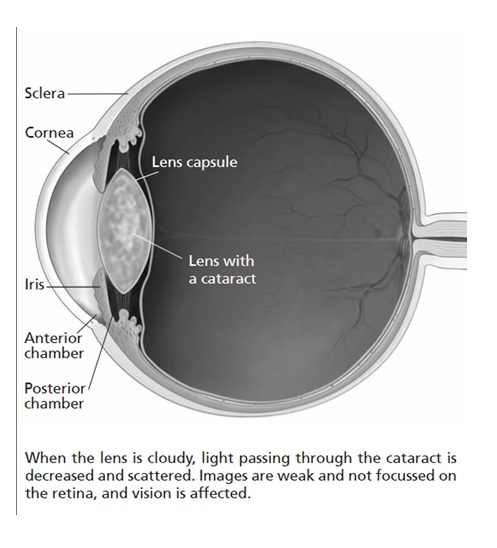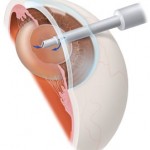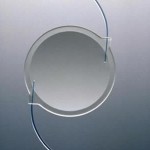Cataract Treatment
دوشنبه 3 اردیبهشت 1397
بازدید: 2250
What is a Cataract?
Cataract occurs as ultraviolet light entering the eye interacts with the proteins in the natural lens within your eye. The clear natural lens becomes cloudy as time goes by. Although this process begins when we are young, it becomes noticeable to your eye doctor normally in your 50′s and 60′s. When the clouding becomes bad enough to cut down or your visual acuity during an eye examination, it is diagnosed as “cataract.” The exact age of onset, rate of progression and severity of cataracts varies from one person to the next. While most cataracts simply come with age, there are a number of risk factors: smoking, diabetes, retinal surgery, family history, prednisone and certain other drugs, trauma, and ocular inflammation.

Symptoms of cataract
Cataracts cause symptoms including blurry vision near and/or far, sensitivity to glare, and an imperceptible but progressive loss of color vision as the lens turns yellow. Generally it is when either the clarity of vision is not good, or when glare sensitivity on bright days or at night that a person seeks help for the cataract. Whenever you have difficulty with your vision, from any cause, you should come in and let us evaluate the situation and diagnose the problem.
How is Cataract Diagnosed?

Cataract is diagnosed in the course of a comprehensive eye examination by your ophthalmologist. The doctors at MarinEyes provide pre-operative consultations, second opinions and post-operative care. We often receive referrals from other doctors, but welcome self-referrals as well.

How is Cataract treated?
Once your vision with corrective glasses or contact lenses is no longer adequate for you to comfortably, safely do your normal activities, it is time to consider cataract surgery. The only effective treatment for cataract is cataract surgery. This is a common procedure. The surgery involves a relaxing sedative and general /“topical” anesthesia for complete comfort. Under microscopic control, the surgeon removes the cloudy lens and replaces it with a new, clear artificial lens.
Steps in Cataract Surgery
Phacoemulsification
Micro Incision Cataract Surgery
Once your vision with corrective glasses or contact lenses is no longer adequate for you to comfortably, safely do your normal activities, it is time to consider cataract surgery. The only effective treatment for cataract is cataract surgery. This is a common procedure. The surgery is done under “general” anesthesia for complete comfort. Under microscopic control, the surgeon removes the cloudy lens and replaces it with a new, clear artificial lens.
The surgery itself generally takes less than 15 minutes in most cases. The patient goes home about 2-3 hours after Surgery. The vision may be blurry for the first few days, but is nearly always much better by 2 weeks postop. Typical post-operative care includes eye drops for 6 weeks after, and 2-3 post-operative follow-up appointments. Occasionally the post-operative care involves higher levels of medication and visits, but most people who will need glasses are ready for new glasses about 2 weeks post surgery. Many of our patients are having multifocal lens implants such as the ReStor and enjoying reduced dependency on glasses. The doctors provide pre-operative consultations, second opinions and post-operative care.
After the surgery
Certain activities should be avoided for several weeks following cataract surgery, including strenuous activity, heavy lifting, bending over and eye rubbing. You may also need to wear a protective eye mask while sleeping.
After the surgery, you may no longer need glasses (or contact lenses) to see clearly. Alternatively, your prescription may change or you may only need glasses for certain activities (many people still need glasses for reading).
Preventing cataracts
There are some things that may help delay or prevent the development of cataracts. These include:
Wearing sunglasses to protect your eyes from UV light – wearing sunglasses in your younger years might help you avoid or postpone the development of cataracts.
Quitting smoking if you smoke.
Reducing your alcohol intake.
Eating a healthy diet that includes plenty of fruit and vegetables. A diet high in fruit and vegies contains plenty of vitamins and minerals, which may help reduce the risk of cataracts. Vitamins A and C are thought to be particularly helpful in preventing cataracts. Fruit and vegetables are also a good source of antioxidants, which are important for eye health.
We try to help you select the best option for your needs and desires. Any of these selections can be excellent for appropriate patients, but for every choice there will be some trade-off. We are happy to try to reduce the need for glasses when requested, but cannot promise either spectacle freedom or perfect vision. All of the potential risks of cataract surgery apply, plus some other considerations: the lenses do not always provide exact correction, and some patients may wish to have an additional laser vision correction to enhance results. Glare and haloes are more often annoying to the multifocal patient than the standard IOL or Toric IOL recipient. Glasses use is highest among standard IOL patients, and lowest for multifocal patients.
دیدگاه های ارسال شده توسط شما، پس از تایید مدیر سایت در وب سایت منتشر خواهد شد.
پیام هایی که حاوی تهمت یا افترا باشد منتشر نخواهد شد.
پیام هایی که به غیر از زبان فارسی یا غیر مرتبط با خبر باشد منتشر نخواهد شد.